The ongoing issue with Nvidia RTX 5000-series graphics cards has manifested again, as reports surface of melting power cable connectors. Despite advances in cable design to counteract this problem, incidents of failures persist, catching both consumers and industry observers by surprise. MSI’s introduction of its yellow-tipped 12V-2×6 power cables was intended as a precautionary measure to ensure proper connection and prevent overheating. These distinctive cables aim to alert users to a secure fit by retaining visible yellow if the connection isn’t fully seated. Yet, a recent report from a user experiencing a melted connector on an RTX 5090 card raises concerns about the effectiveness of these designs. It indicates that despite color-coded cues, the cables may still become compromised under certain conditions, undermining the reliability of these precautions.
User Experience and Setup
The specific incident, which was thoroughly discussed in the QuasarZone BBS thread, underscores both commonality and uniqueness. A user reported using a Super Flower 1300W PSU to power his setup, which consistently resulted in frequent blue screens of death. Upon meticulous examination, the user discovered a damaged GPU-end connector on the card, raising alarms about the integrity of the connection. This finding came after gaming activities that demanded approximately 400W for around two hours. Notably, these failures are not isolated to this particular series, aligning with previous observations seen in the older RTX 4090 series. The recurring theme of inadequate cable performance signals a potential vulnerability that remains unresolved. Despite permission issues leading to hardware failures, the RTX 5090 card itself appeared unharmed, allowing the user to avert complete disaster.
Addressing Design and Safety Concerns
This situation underscores a larger issue for Nvidia and other tech companies. Well-intended design improvements, while theoretically sound, may not completely eliminate the risk of incorrect cable connections leading to damage. Users need thorough guidance on the correct setup and regular maintenance procedures to ensure optimal safety and performance. This need remains even with clearly labeled connectors, highlighting user vigilance and informed engineering as crucial to averting risks. Tech stakeholders are driven to explore further innovations, aiming for consumer safety and product reliability through redesign and extensive user education. Future efforts may encompass component upgrades and comprehensive educational resources to minimize failures under complex conditions. The industry’s need for a holistic approach reflects ongoing challenges in balancing cutting-edge performance with absolute reliability. This signifies an industry still wrestling with the demands of offering both high performance and unwavering reliability to end-users.

